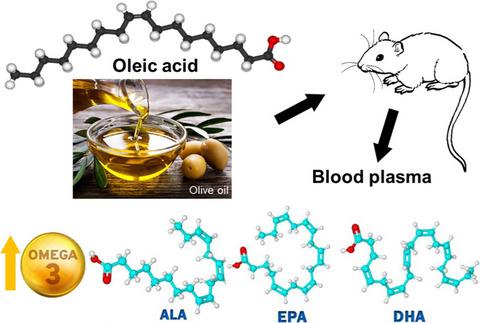当前位置:
X-MOL 学术
›
Food Sci. Nutr.
›
论文详情
Our official English website, www.x-mol.net, welcomes your feedback! (Note: you will need to create a separate account there.)
High dietary oleic acid in olive oil-supplemented diet enhanced omega-3 fatty acid in blood plasma of rats.
Food Science & Nutrition ( IF 3.9 ) Pub Date : 2020-05-19 , DOI: 10.1002/fsn3.1644 Kim Margarette C Nogoy 1 , Hyoun Ju Kim 2 , Yehyun Lee 1 , Yan Zhang 1 , Jia Yu 1 , Dong Hoon Lee 3 , Xiang Zi Li 4 , Stephen B Smith 5 , Hyun A Seong 6 , Seong Ho Choi 1
Food Science & Nutrition ( IF 3.9 ) Pub Date : 2020-05-19 , DOI: 10.1002/fsn3.1644 Kim Margarette C Nogoy 1 , Hyoun Ju Kim 2 , Yehyun Lee 1 , Yan Zhang 1 , Jia Yu 1 , Dong Hoon Lee 3 , Xiang Zi Li 4 , Stephen B Smith 5 , Hyun A Seong 6 , Seong Ho Choi 1
Affiliation

|
This study was conducted to investigate the effect of dietary oleic acid in olive oil‐supplemented diets on the blood lipid profile and fatty acid composition in blood plasma and adipose tissue of rats. A total of 60 Sprague Dawley rats with mean body weight of 249 g ± 3.04 g were equally divided into three diet groups: control (CON) contained 10% coconut oil, olive50 contained 5% coconut oil and 5% olive oil, and olive100 contained 10% olive oil. Oleic acid (OA) level was highest in olive100 followed by the olive50 and control. The final body weight (BW) of the rats was significantly affected by the intake of OA, in which rats fed olive100 had the lowest final BW, which signified that OA could be associated with weight loss. Olive oil intake significantly increased levels of the high‐density lipoprotein cholesterol (HDL‐C) and exhibited a potential attenuation effect on the glutamic‐oxaloacetic transaminase and the glutamic‐pyruvic transaminase, and a potential role in the reduction of triglycerides in the bloodstream of the animals. In terms of fatty acid composition, significantly high OA was observed in the blood plasma and adipose tissues of rats fed olive100. Omega‐3 polyunsaturated fatty acids (PUFAs), such as linolenic (C18:3 n−3), eicosapentaenoic (C20:5 n−3), and docosahexaenoic (C22:6 n−3), and n−6 PUFA arachidonic (C20:4 n−6) were also significantly increased in the blood plasma of rats fed olive100. These findings suggest that the intake of dietary high OA may enhance the omega‐3 fatty acid levels in the blood plasma of rats and may have a positive effect in reducing risks to cardiovascular disease, as evidenced by weight loss, increased HDL‐C levels, and decreased TG levels in the blood plasma of experimental animals.
中文翻译:

补充橄榄油的高饮食油酸可增强大鼠血浆中的omega-3脂肪酸。
这项研究旨在研究补充橄榄油的饮食中油酸对大鼠血浆和脂肪组织的血脂谱和脂肪酸组成的影响。将60只平均体重为249 g±3.04 g的Sprague Dawley大鼠平均分为三个饮食组:对照组(CON)包含10%椰子油,olive50包含5%椰子油和5%橄榄油,而olive100包含10%橄榄油。油橄榄(OA)中的油酸(OA)水平最高,其次是橄榄50和对照。大鼠的最终体重(BW)受OA摄入量的显着影响,其中以olive100喂养的大鼠的最终体重最低,这表明OA可能与体重减轻有关。橄榄油的摄入显着增加了高密度脂蛋白胆固醇(HDL-C)的水平,并且对谷氨酸-草酰乙酸转氨酶和谷氨酸-丙酮酸转氨酶均具有潜在的抑制作用,并且在减少血中甘油三酸酯方面可能发挥作用。这些动物。就脂肪酸组成而言,在喂食了Olive100的大鼠的血浆和脂肪组织中观察到明显高的OA。欧米茄3多不饱和脂肪酸(PUFA),例如亚麻酸(C18:3n -3),二十碳五烯酸(C20:5 n -3)和二十二碳六烯酸(C22:6 n -3)和n -6 PUFA花生四烯酸(C20:4 n -6)在大鼠血浆中也显着增加喂橄榄 这些发现表明,饮食中高OA的摄入可能会提高大鼠血浆中的omega-3脂肪酸水平,并且可能在降低心血管疾病风险方面具有积极作用,如体重减轻,HDL-C水平升高,并降低实验动物血浆中的TG水平。
更新日期:2020-05-19
中文翻译:

补充橄榄油的高饮食油酸可增强大鼠血浆中的omega-3脂肪酸。
这项研究旨在研究补充橄榄油的饮食中油酸对大鼠血浆和脂肪组织的血脂谱和脂肪酸组成的影响。将60只平均体重为249 g±3.04 g的Sprague Dawley大鼠平均分为三个饮食组:对照组(CON)包含10%椰子油,olive50包含5%椰子油和5%橄榄油,而olive100包含10%橄榄油。油橄榄(OA)中的油酸(OA)水平最高,其次是橄榄50和对照。大鼠的最终体重(BW)受OA摄入量的显着影响,其中以olive100喂养的大鼠的最终体重最低,这表明OA可能与体重减轻有关。橄榄油的摄入显着增加了高密度脂蛋白胆固醇(HDL-C)的水平,并且对谷氨酸-草酰乙酸转氨酶和谷氨酸-丙酮酸转氨酶均具有潜在的抑制作用,并且在减少血中甘油三酸酯方面可能发挥作用。这些动物。就脂肪酸组成而言,在喂食了Olive100的大鼠的血浆和脂肪组织中观察到明显高的OA。欧米茄3多不饱和脂肪酸(PUFA),例如亚麻酸(C18:3n -3),二十碳五烯酸(C20:5 n -3)和二十二碳六烯酸(C22:6 n -3)和n -6 PUFA花生四烯酸(C20:4 n -6)在大鼠血浆中也显着增加喂橄榄 这些发现表明,饮食中高OA的摄入可能会提高大鼠血浆中的omega-3脂肪酸水平,并且可能在降低心血管疾病风险方面具有积极作用,如体重减轻,HDL-C水平升高,并降低实验动物血浆中的TG水平。


























 京公网安备 11010802027423号
京公网安备 11010802027423号